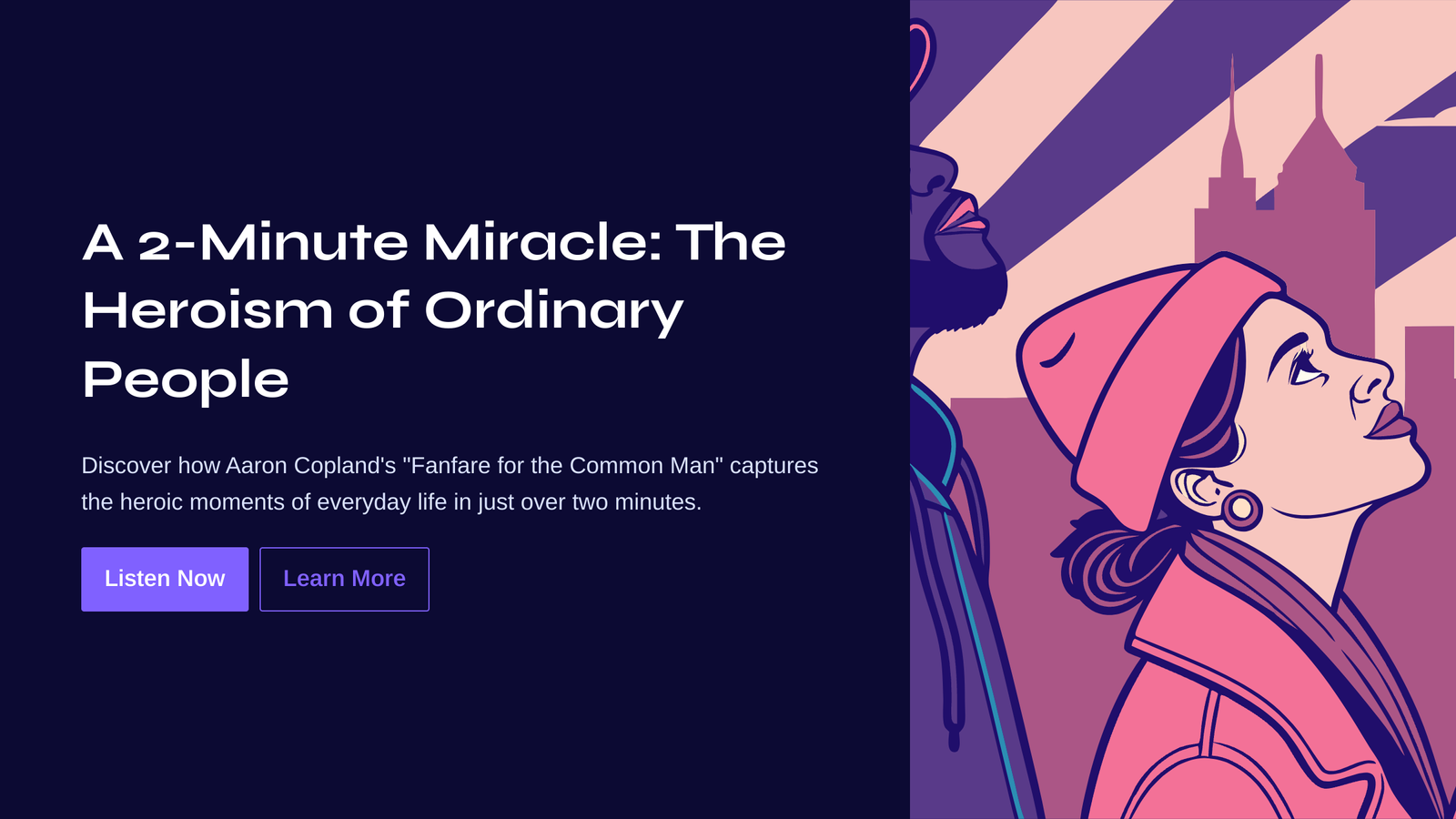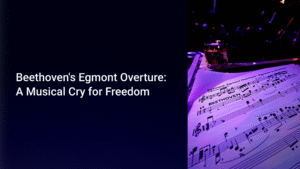Table of Contents
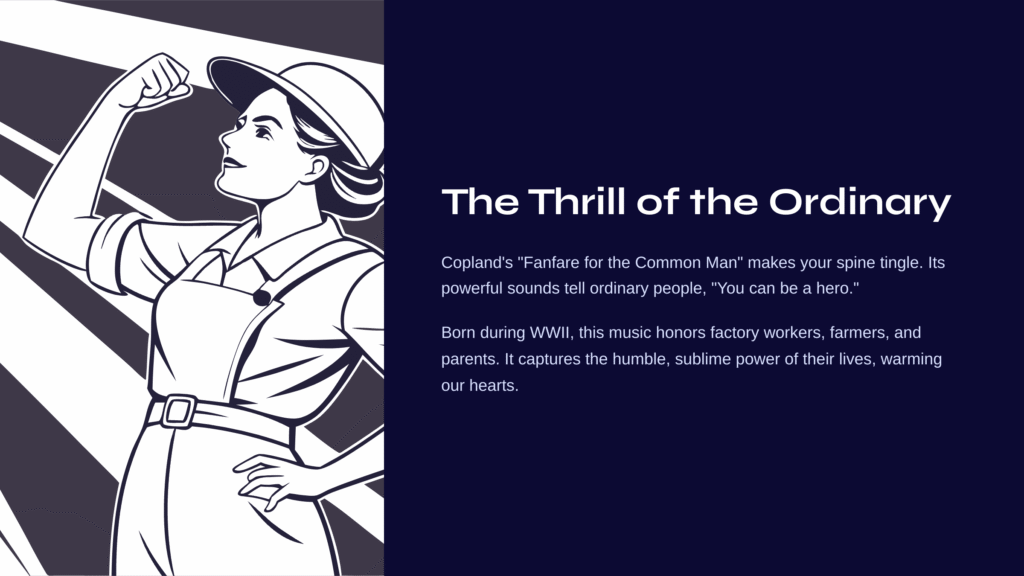
The Thrill of the Ordinary
Some music straightens your spine the moment you hear it. When the deep, weighty strike of the tam-tam slices through the air, when the majestic rumble of timpani that follows beats against your heart, we instinctively sense that something extraordinary is beginning. Copland’s *Fanfare for the Common Man* is precisely such music. In just 2 minutes and 30 seconds, this piece whispers to everyone living ordinary lives: “You too can be a hero.”
Born in 1942 amidst the fires of world war, this music was not created for the gilded salons of aristocrats, but for ordinary people—those who work in factories, sweat in fields, and raise children. When we listen to this work that captures the humble yet sublime power of their lives, we find our hearts warming without even realizing it.
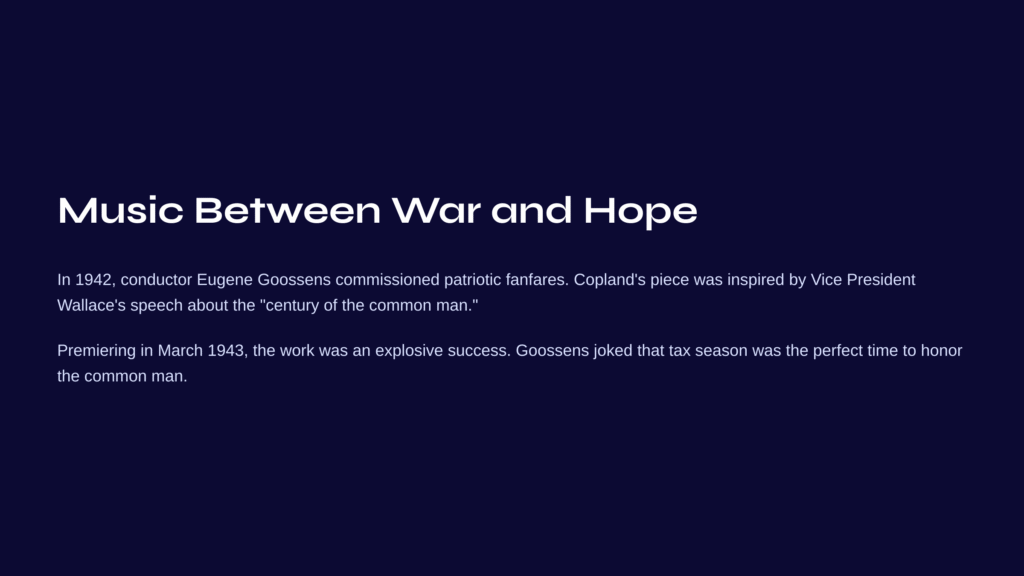
Music That Blossomed Between War and Hope
In August 1942, Eugene Goossens, conductor of the Cincinnati Symphony Orchestra, made a special proposal. To commemorate America’s entry into World War II, he commissioned 18 American composers to write patriotic fanfares. For Copland, already known as the “national composer” for his distinctly American musical works, this was a fateful commission.
Copland initially considered several titles: *Fanfare for a Solemn Ceremony*, *Fanfare for Four Freedoms*, and others. But the decisive inspiration came from Vice President Henry Wallace’s speech. In May 1942, Wallace declared, “The century on which we are entering can be and must be the century of the common man.” Deeply moved by these words, Copland finally settled on *Fanfare for the Common Man*.
The completion of the work took only a few months. Yet in that brief time, Copland created an immortal masterpiece that would forever remain in American musical history. The premiere on March 12, 1943, in Cincinnati elicited an explosive response. Goossens wittily chose March, tax season, explaining it was “the ideal time to honor the common man.”
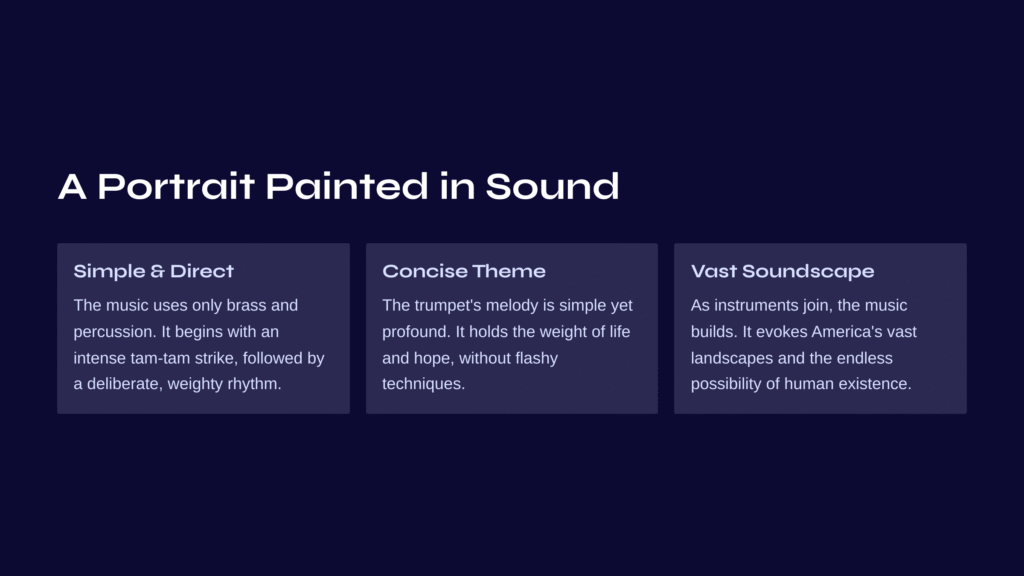
A Portrait of Ordinariness Painted in Sound
The musical structure of *Fanfare for the Common Man* is as simple and direct as its message. Composed for just four horns, three trumpets, three trombones, tuba, and percussion, this work is thoroughly moving without the aid of elaborate strings.
Beginning with the intense strike of the tam-tam, this music feels like a ritual opening the door to a new era. The rhythm of the bass drum and timpani that follows evokes marching footsteps, but unlike typical fanfares, it carries the marking “very deliberately.” It doesn’t rush. It doesn’t show off. Instead, through its weighty and majestic resonance, it demonstrates what true dignity means.
The main theme presented by the trumpets is remarkably concise. There are no complex ornamentations or flashy techniques to be found. Yet within that simplicity lies an indescribable depth. Like the lines etched on the face of someone who has walked their path quietly for years, this melody holds both the weight of life and hope simultaneously.
As horns, trombones, and tuba gradually join in, the music builds layer upon layer. Copland’s favored parallel fourths and fifths create an open sonority, evoking the vast landscapes of the American continent. This transcends merely American coloring to musically embody the vastness and possibility inherent in human existence itself.
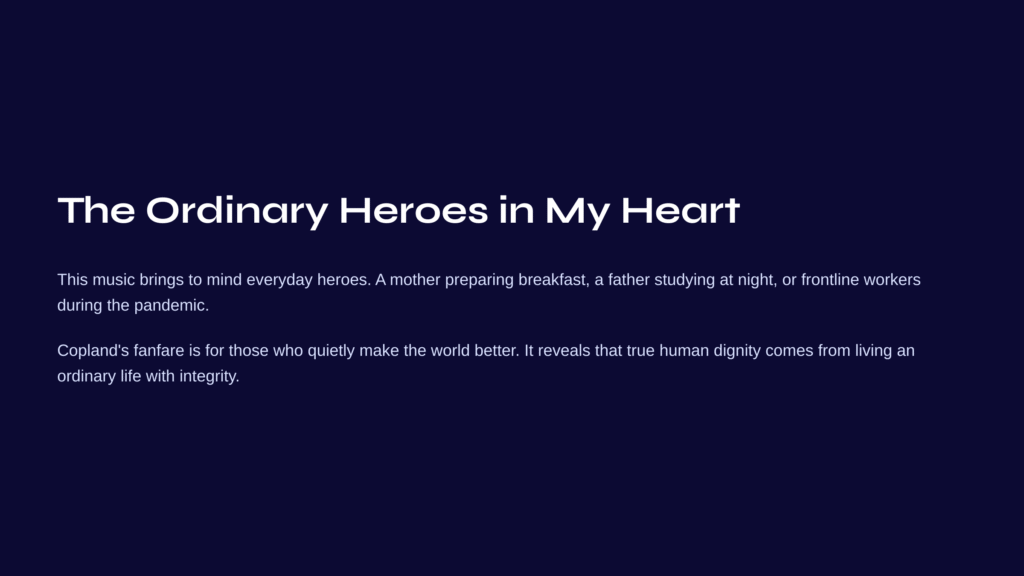
The Ordinary Heroes in My Heart
Every time I hear this music, I think of special moments. The image of a mother waking early to prepare breakfast for her family, the silhouette of a father studying at night school after work, the faces of healthcare workers and delivery drivers who kept their posts despite danger during the COVID pandemic—all pass by with the music.
Copland’s fanfare is music for precisely such people. Those who don’t make newspaper headlines but possess the power to actually move the world. Those who don’t package themselves in grandiose rhetoric but make the world a little better each day through daily faithfulness.
When the music reaches its climax, in that majestic harmony created by all the brass instruments united as one, I understand what human dignity truly means. It doesn’t come from special talents or achievements, but from the very act of living ordinary daily life with integrity.
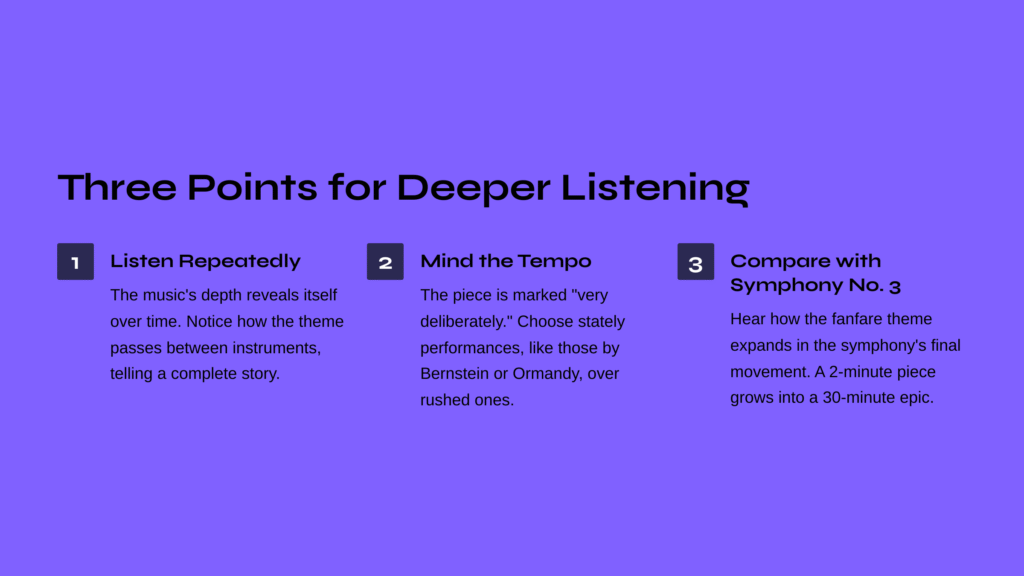
Three Points for Deeper Listening
First, the true charm of this music emerges through repeated listening. While it may seem simple at first hearing, the more you listen, the more you discover the depth hidden within that simplicity. Pay special attention to how each instrument passes along the theme. Listen carefully to how the melody that begins with the trumpet continues through horn and trombone, changing and developing—it’s like hearing multiple voices complete a single story.
Second, when listening to this piece, pay particular attention to tempo. As marked “very deliberately,” this music doesn’t rush. It’s better to choose performances that maintain a spacious, stately tempo rather than those played at quick speeds. Recordings by Leonard Bernstein or Eugene Ormandy are particularly recommended.
Third, if possible, listen to it alongside the fourth movement of Copland’s Symphony No. 3. Comparing how this fanfare’s theme is expanded and developed in the symphony makes for a fascinating experience. You can witness how a 2-minute 30-second fanfare grows into a symphonic movement lasting over 30 minutes.
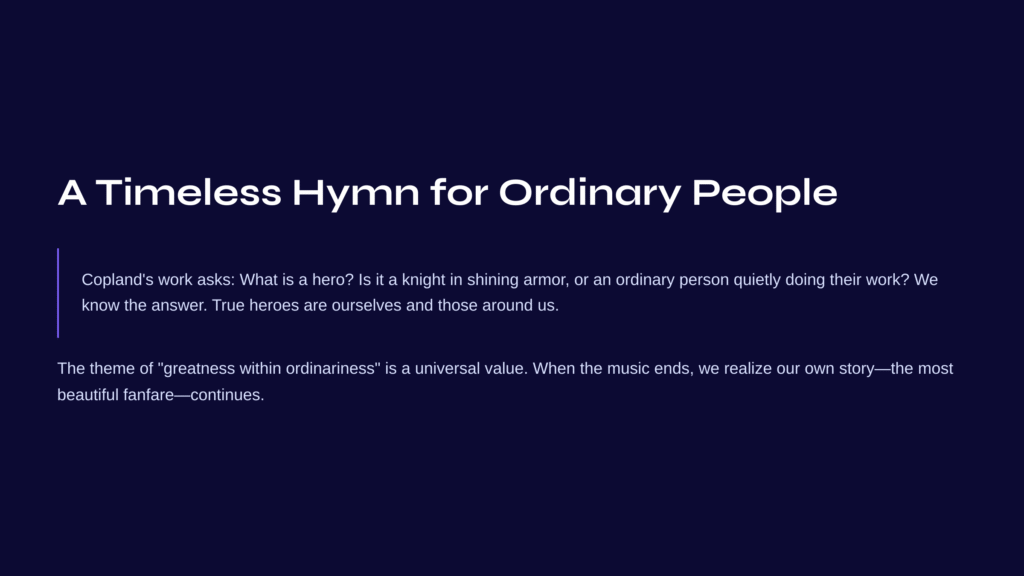
A Timeless Hymn for Ordinary People
More than 80 years have passed, yet *Fanfare for the Common Man* still delivers a powerful message to us today. The theme of “greatness within ordinariness” that this music embodies represents universal values that transcend time.
Through this work, Copland asks us: What exactly is a hero? Is it a knight in shining armor on horseback, or is it an ordinary person who gets up each morning and quietly does their work? Listening to this music, we know the answer. True heroes are ourselves and the ordinary people around us.
When the final resonance of the tam-tam fades into the air, we quietly realize that while the music has ended, our story continues. And that story is the most beautiful fanfare in the world.
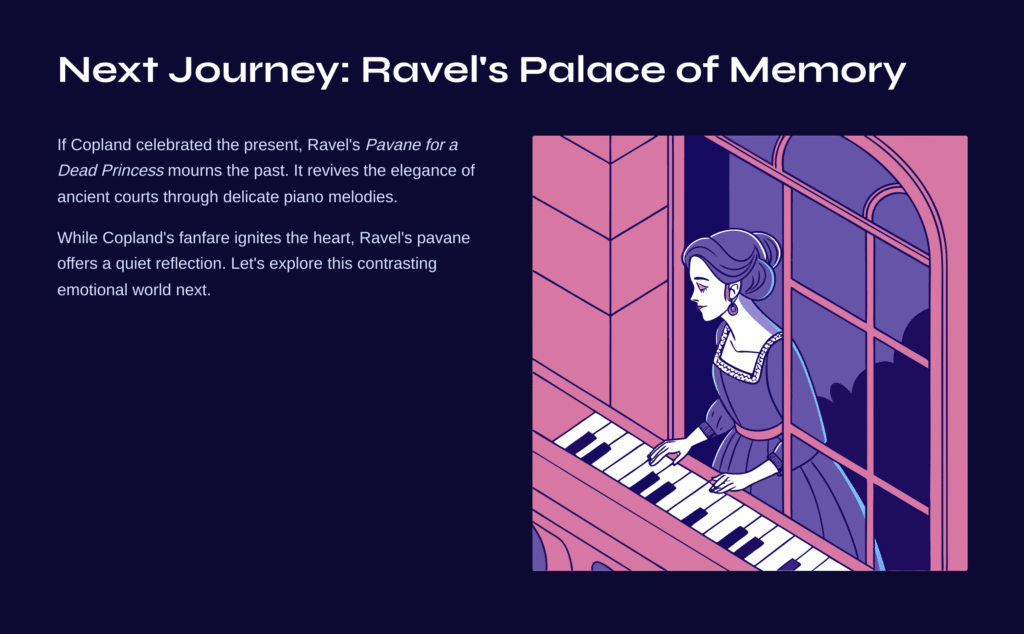
Next Journey: Ravel’s Palace of Memory
If Copland’s fanfare represents the vigorous footsteps of ordinary people living in the present, Ravel’s *Pavane for a Dead Princess* is a quiet requiem for beautiful moments that have vanished into the past. Though the two works differ completely in era, country, and atmosphere, they share a curious commonality: “deep affection for things that are disappearing.”
While Copland commemorated the value of forgotten ordinary people through music, Ravel revived the elegance of ancient courts that no longer exist through piano melodies. Created by the 24-year-old Ravel in 1899, this work is a dance piece for an imaginary Spanish princess, not an actual historical figure. Yet that fictional sorrow approaches us as an even more universal beauty.
Instead of the grandeur of brass instruments, Ravel uses the delicate touch of piano; instead of a victorious fanfare, he offers melodies of remembrance, leading us into another emotional world entirely. If Copland’s fanfare set your heart ablaze, perhaps it’s time to let Ravel’s pavane quietly cool that fire. Sometimes contrasting emotions are exactly what make each other more vivid.
